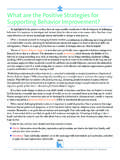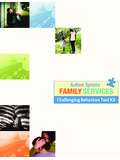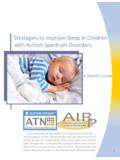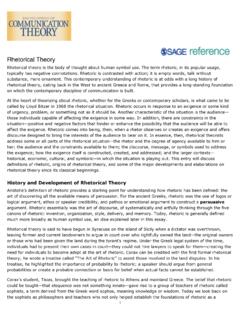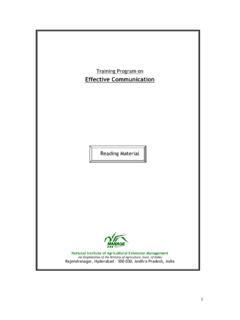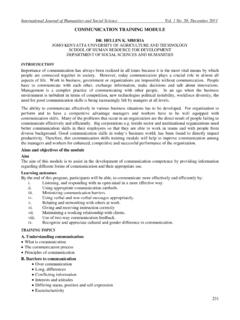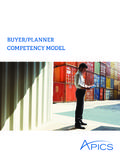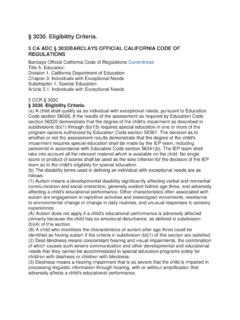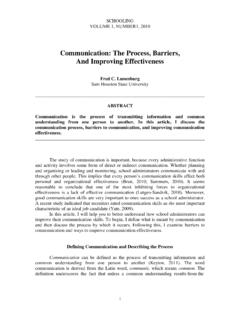Transcription of Is it autism and if so, what next? - Autism Speaks
1 Is it Autism and if so, what next? A guide for adultsA guide for adultsIs it Autism and if so,what next? IS IT Autism ? A GUIDE FOR ADULTSA cknowledgements Autism Speaks would like to extend special thanks to those who contributed to the kit for their time and effort:CONTRIBUTORSD avid Beversdorf, Thompson Center for Autism and Neurodevelopmental Disabilities Megan Farley, Waisman Center for Developmental DisabilitiesEric Kirschner Kerry Magro Paul Nussbaum Valerie Paradiz, David Powell Samantha Ranaghan Stephen Shore, Jeremy Sicile-Kira John Taylor Sondra Williams Gillian WilsonAbout This Kit Is It Autism and If So, What Next? A Guide for Adults is a tool designed to help assist adults who suspect they may have Autism , as well as those who have been recently diagnosed with the disorder. This tool kit was released in the spring of 2015. It was created by the Autism Speaks Family Services staff, in conjunction with a group of contributors made up of adults with Autism and other profession-als, as well as the Family Services Committee.
2 Autism SPEAK FAMILY SERVICES COMMITTEEAmit BasakParentLiz Bell ParentSallie Bernard* Parent, Executive Director, SafeMindsCuong Do* ParentPeter Faustino, New York Association of School PsychologistsPeter F. Gerhardt, Former President, Organization for Autism Research (OAR)Mel Karmazin* GrandparentBrian Kelly * ** ParentArtie Kempner* ParentGary S. Mayerson* Founding Attorney, Mayerson & AssociatesLinda Meyer, , MPA, BCBA-D, CPT Autism ConsultantKevin Murray* ParentDanny Openden, , President and CEO, Southwest Autism Research and Resource Center (SARRC)Valerie Paradiz, Director, Valerie Paradiz, LLCD irector Autistic Global Initiative, Parent, Self-advocateLori Rickles ParentStuart Savitz* ParentPaul Shattuck, Leader, AJ Drexel Autism Institute Research Program Area on Life Course Outcomes Stephen Shore, Assistant Professor, Special Education, Adelphi UniversityMichelle Smigel Parent* Autism Speaks board member **Chairperson Family Services Committee Parent indicates a parent of a child with autismIs IT Autism ?
3 A guIde for adulTs 2015 Autism Speaks Inc., Autism Speaks , and Autism Speaks It s Time to Listen & Design, as well as Autism Speaks Light It Up Blue, are registered trademarks owned by Autism Speaks Inc. All rights reserved. The use of these trademarks by unaffiliated representatives for endorsement, advertising, promotional, and sales materials is prohibited by Speaks does not provide medical or legal advice or services. Rather, Autism Speaks providesgeneral information about Autism as a service to the community. The information provided in this tool kitis not a recommendation, referral or endorsement of any resource, therapeutic method, or service provider and does not replace the advice of medical, legal or educational professionals. Autism Speaks has not validated and is not responsible for any information or services provided by third parties. You areurged to use independent judgment and request references when considering any resource associated with the provision of services related to s time to tool kit for adults who suspect they may haveautism, as well as those who have been recentlydiagnosed with the IT Autism ?
4 A GUIDE FOR ADULTST able of ContentsIntroduction What is Autism ? 1 What are the Symptoms of Autism ? 3 Strengths and Challenges by Stephen Shore 5 Medical and Psychiatric Issues that May Accompany Autism 6 How Do I Get a Diagnosis? 9 Why Do I Need a Diagnosis? 11My Story: Diagnosed with Autism at 34 12 How is Autism Treated? 13 From Denial to Acceptance: I Was Diagnosed with Autism at 24 15 What Are My Rights? Tell or Not to Tell? 18 Conclusion 19 Glossary 20 Resources 24Is It Autism ? a guIde for adultsIntroductionYou have downloaded or ordered this tool kit because you suspect you may have Autism or you ve received a new diagnosis as an adult.
5 You have come to the right place!As Autism awareness has grown dramatically in recent years, many young adults and adults have learned the signs and felt there may be a connection between their feelings and behaviors and the symptoms of Autism . For some, it can come as a relief as questions they ve had for many years may finally have an answer. Many have been misdiagnosed with other conditions or were never able to get a formal diagnosis of a condition or disorder that explains their kit will provide an overview of Autism to help you better understand the disorder and will hopefully clarify whether you should seek out a professional for a thorough evaluation. If/When you are in fact diagnosed with Autism , the kit will also walk you through next steps in terms of accessing services and provide you with critical information about your rights and entitlements as an adult on the spectrum.
6 There is also a list of helpful resources for you to find more information about next steps for the days and months following your you have any additional questions or are looking for resources, the Autism Speaks Autism Response Team (ART) is here to help! ART coordinators are specially trained to help support the Autism community by answering calls and emails and by providing guidance and information. The Autism Response Team can be reached by email at or by phone at 888-288-4762 (en Espa ol at 888-772-9050).Let s get started!Is It Autism ? a guIde for adultsWhat is Autism ? Autism spectrum disorder (ASD) and Autism are both general terms for a group of complex disorders of brain development characterized, in varying degrees, by difficulties in social interaction, verbal and nonverbal communication and repetitive behaviors. Though there are strengths and unique abilities associated with the disorder, Autism is most often defined based on deficits and symptoms because the definition from the American Psychiatric Association s Diagnostic and Statistical Manual of Mental Disorders (DSM) is science-based and the manual is used to describe disorders for diagnosis.
7 With the May 2013 publication of the fifth edition of the DSM (commonly referred to as the DSM-5), all Autism disorders were merged under one umbrella diagnosis of ASD. Previously, they were recognized as distinct subtypes, including autistic disorder, childhood disintegrative disorder, pervasive developmental disorder-not otherwise specified (PDD-NOS) and Asperger Syndrome. Individuals with well-established diagnoses of these disorders prior to the publication of the DSM-5 should now be given the diagnosis of Autism spectrum the current DSM-5, there are two domains where people with ASD must show persistent deficits. They include:1. persistent social communication and social interaction2. restricted and repetitive patterns of behaviorMore specifically, people with ASD must demonstrate deficits (either in the past or in the present) in social-emotional reciprocity, nonverbal communicative behaviors used for social interaction, as well as deficits in developing, maintaining and understanding relationships.
8 In addition, they must show at least two types of repetitive patterns of behavior including: stereotyped or repetitive motor movements insistence on sameness or inflexible adherence to routines highly restricted, fixated interests hyper- or hypo-reactivity to sensory input or unusual interest in sensory aspects of the environmentThe DSM-5 also added an additional category called Social communication Disorder (SCD). This allows for a diagnosis of disabilities in social communication , without the presence of repetitive behavior. SCD is a new diagnosis and much more research and information is needed to better understand it. There are currently few guidelines for the treatment of SCD. Until such guidelines become available, treatments that target social- communication , including many Autism -specific interventions, should be provided to individuals with read the whole DSM-5 criteria, please visit 1Is IT Autism ?
9 A guIde for adulTsHow Common is Autism ?While no studies have been able to confi rm the prevalence rate for adults and more research is needed, Autism statistics from the Centers for Disease Control and Prevention (CDC) released in March 2014 identify around 1 in 68 American children as on the Autism spectrum a ten-fold increase in prevalence in 40 years. Careful research shows that this increase is only partly explained by improved diagnosis and awareness. Studies also show that Autism is four to fi ve times more common among boys than girls. An estimated 1 out of 42 boys and 1 in 189 girls are diagnosed with Autism in the United affects over 2 million individuals in the and tens of millions worldwide. Government autismstatistics suggest that prevalence rates have increased 10 to 17% annually in recent years. There is no established explanation for this continuing increase, although improved diagnosis and environmental infl uences are two reasons often Causes Autism ?
10 Not long ago, the answer to this question would have been, we have no idea. Research is now starting to deliver the answers. First and foremost, we now know that there is no one cause of Autism , just as there is no one type of Autism . Over the last fi ve years, scientists have identifi ed a number of rare gene changes or mutations associated with Autism . Research has identifi ed more than 100 Autism risk genes. In around 15% of cases, a specifi c genetic cause of a person s Autism can be identifi ed. However, most cases involve a complex and variable combination of genetic risk and environmental factors that infl uence early brain development. In other words, in the presence of genetic predisposition to Autism , a number of non-genetic or environmental infl uences further increase an individual s risk. Some factors that have been identifi ed to increase the risk of Autism include parental age, extreme prematurity, diffi culties during birth, mothers exposed to high levels of pesticides and air pollution.
